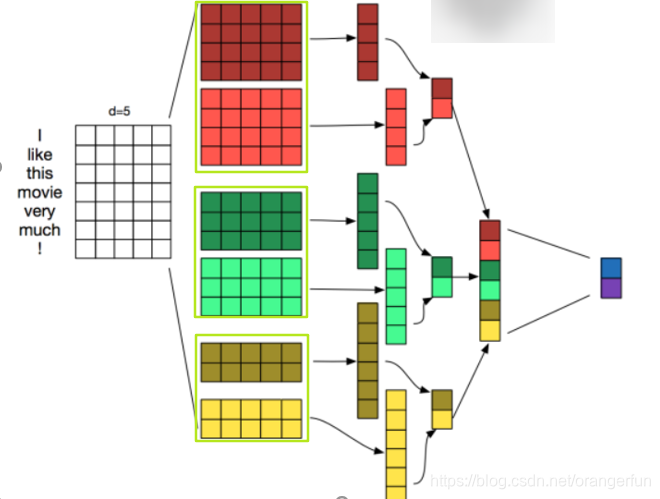- 1学Python有什么用?能做什么?有哪些行业需要用到Python?_python编程有什么用
- 2GPT如何快速写论文_gpt3.5如何写论文
- 3华为鸿蒙os手机版,华为鸿蒙os2.0系统正式版安装包下载-华为鸿蒙2.0系统手机版v2.0安卓版_289手游网下载...
- 4对nand flash设备进行升级_memgetbadblock
- 5RASA2.0 搭建中文聊天机器人(附gitee源码)_flask部署rasa对话机器人模型部署
- 6【小米】刷入第三方ROM统一教程_小米第三方rom
- 7github FATAL:unable to access 'https://github.com/...: Failed to connect to github.com:443; No error
- 8Ubuntu 操作系统安装 Python(并更新python,pip)
- 9计算机安全弹窗,win10系统打开网页老是弹出安全警告的方法
- 10路由器连接WIFI组网_easyfatap
BERT(5)---实战[BERT+CNN文本分类]_bert结合cnn文本分类
赞
踩
1. 模型介绍
获取bert模型最后的token-level形式的输出(get_sequence_output)也就是transformer模型最后一层的输出,将此作为embedding_inputs,作为卷积的输入;用三个不同的卷积核进行卷积和池化,最后将三个结果concat,三种不同的卷积核大小为[2, 3, 4];每种卷积核的数量都为128个;卷积流程类似下图所示,但实际上有所区别,下图表示的是使用大小为[2, 3, 4]三种卷积核,每种卷积核数量为2。

卷积后的输出形状大小为[batchsize, num_filters*len(filter_size)]=[batchsize, 128*3];将该输出再连接两个全连接层,后一个全连接层用作分类。
2. 数据处理及训练
因为数据先放入BERT模型中, 再将BERT的输出接入CNN, 因此我们需要将数据处理成BERT模型能接收的格式,所以此处数据处理大多参考BERT源码中的数据处理方式
首先依然类似BERT fine-tuning章节中所述自定义一个类来处理原始数据,在该类中主要实现以下功能:加载训练、测试、验证数据, 设置分类标签,具体实现如下:
class TextProcessor(object):
"""按照InputExample类形式载入对应的数据集"""
"""load train examples"""
def get_train_examples(self, data_dir):
return self._create_examples(
self._read_file(os.path.join(data_dir, "train.tsv")), "train")
"""load dev examples"""
def get_dev_examples(self, data_dir):
return self._create_examples(
self._read_file(os.path.join(data_dir, "dev.tsv")), "dev")
"""load test examples"""
def get_test_examples(self, data_dir):
return self._create_examples(
self._read_file(os.path.join(data_dir, "test.tsv")), "test")
"""set labels"""
def get_labels(self):
return ['sport', 'military', 'aerospace', 'car', 'business', 'chemistry', 'construction', 'culture', 'electric', 'finance', 'geology', 'it', 'law', 'mechanical', 'medicine', 'tourism']
"""read file"""
def _read_file(self, input_file):
with codecs.open(input_file, "r",encoding='utf-8') as f:
lines = []
for line in f.readlines():
try:
line=line.split('\t')
assert len(line)==2
lines.append(line)
except:
pass
np.random.shuffle(lines)
return lines
"""create examples for the data set """
def _create_examples(self, lines, set_type):
examples = []
for (i, line) in enumerate(lines):
guid = "%s-%s" % (set_type, i)
text_a = tokenization.convert_to_unicode(line[1])
label = tokenization.convert_to_unicode(line[0])
examples.append(
InputExample(guid=guid, text_a=text_a, text_b=None, label=label))
return examples
- 1
- 2
- 3
- 4
- 5
- 6
- 7
- 8
- 9
- 10
- 11
- 12
- 13
- 14
- 15
- 16
- 17
- 18
- 19
- 20
- 21
- 22
- 23
- 24
- 25
- 26
- 27
- 28
- 29
- 30
- 31
- 32
- 33
- 34
- 35
- 36
- 37
- 38
- 39
- 40
- 41
- 42
- 43
- 44
- 45
- 46
通过上面的代码我们得到example仅仅是BERT中的text_a, text_b, label这还不能作为BERT模型的输入,我们需要将其转成[CLS] + 分词好的text_a + [SEP] + 分词好的text_b的形式送入BERT模型中。因此定义convert_examples_to_features函数将所有的InputExamples样本数据转化成模型要输入的token形式,最后输出bert模型需要的四个变量input_ids, input_mask, segment_ids, label_ids
def convert_examples_to_features(examples,label_list, max_seq_length,tokenizer):
label_map = {}
for (i, label) in enumerate(label_list):
label_map[label] = i
input_data=[]
for (ex_index, example) in enumerate(examples):
tokens_a = tokenizer.tokenize(example.text_a)
if ex_index % 10000 == 0:
tf.logging.info("Writing example %d of %d" % (ex_index, len(examples)))
if len(tokens_a) > max_seq_length - 2:
tokens_a = tokens_a[0:(max_seq_length - 2)]
tokens = []
segment_ids = []
tokens.append("[CLS]")
segment_ids.append(0)
for token in tokens_a:
tokens.append(token)
segment_ids.append(0)
tokens.append("[SEP]")
segment_ids.append(0)
input_ids = tokenizer.convert_tokens_to_ids(tokens)
input_mask = [1] * len(input_ids)
while len(input_ids) < max_seq_length:
input_ids.append(0)
input_mask.append(0)
segment_ids.append(0)
assert len(input_ids) == max_seq_length
assert len(input_mask) == max_seq_length
assert len(segment_ids) == max_seq_length
label_id = label_map[example.label]
if ex_index < 3:
tf.logging.info("*** Example ***")
tf.logging.info("guid: %s" % (example.guid))
tf.logging.info("tokens: %s" % " ".join([tokenization.printable_text(x) for x in tokens]))
tf.logging.info("input_ids: %s" % " ".join([str(x) for x in input_ids]))
tf.logging.info("input_mask: %s" % " ".join([str(x) for x in input_mask]))
tf.logging.info("segment_ids: %s" % " ".join([str(x) for x in segment_ids]))
tf.logging.info("label: %s (id = %d)" % (example.label, label_id))
features = collections.OrderedDict()
features["input_ids"] = input_ids
features["input_mask"] = input_mask
features["segment_ids"] = segment_ids
features["label_ids"] =label_id
input_data.append(features)
return input_data
- 1
- 2
- 3
- 4
- 5
- 6
- 7
- 8
- 9
- 10
- 11
- 12
- 13
- 14
- 15
- 16
- 17
- 18
- 19
- 20
- 21
- 22
- 23
- 24
- 25
- 26
- 27
- 28
- 29
- 30
- 31
- 32
- 33
- 34
- 35
- 36
- 37
- 38
- 39
- 40
- 41
- 42
- 43
- 44
- 45
- 46
- 47
- 48
- 49
- 50
- 51
- 52
- 53
然后加载保存好的BERT预训练模型,然后开始训练,当然我们训练时候是每次传入一个batch的数据,因此我们还需要将刚才处理好的数据打包,每次送给模型一个batch的数据,训练过程如下:
for epoch in range(config.num_epochs):
batch_train = batch_iter(trian_data,config.batch_size)
start = time.time()
tf.logging.info('Epoch:%d'%(epoch + 1))
for batch_ids,batch_mask,batch_segment,batch_label in batch_train:
feed_dict = feed_data(batch_ids,batch_mask,batch_segment,batch_label, config.keep_prob)
_, global_step, train_summaries, train_loss, train_accuracy = session.run([model.optim, model.global_step,
merged_summary, model.loss,
model.acc], feed_dict=feed_dict)
tf.logging.info('step:%d'%(global_step))
if global_step % config.print_per_batch == 0:
end = time.time()
val_loss,val_accuracy=evaluate(session,dev_data)
merged_acc=(train_accuracy+val_accuracy)/2
if merged_acc > best_acc:
saver.save(session, save_path)
best_acc = merged_acc
last_improved=global_step
improved_str = '*'
else:
improved_str = ''
tf.logging.info("step: {},train loss: {:.3f}, train accuracy: {:.3f}, val loss: {:.3f}, val accuracy: {:.3f},training speed: {:.3f}sec/batch {}".format(
global_step, train_loss, train_accuracy, val_loss, val_accuracy,(end - start) / config.print_per_batch,improved_str))
start = time.time()
if global_step - last_improved > config.require_improvement:
tf.logging.info("No optimization over 1500 steps, stop training")
flag = True
break
if flag:
break
config.lr *= config.lr_decay
- 1
- 2
- 3
- 4
- 5
- 6
- 7
- 8
- 9
- 10
- 11
- 12
- 13
- 14
- 15
- 16
- 17
- 18
- 19
- 20
- 21
- 22
- 23
- 24
- 25
- 26
- 27
- 28
- 29
- 30
- 31
- 32
3.搭建服务
使用tornado搭建服务,如下所示
class ClassifierHandler(tornado.web.RequestHandler):
def post(self):
error_logger = Logger(loggername="bert_cnn_error_" + time.strftime("%Y_%m_%d", time.localtime()), logpath=LOGPATH + "bert_cnn_error_" + time.strftime("%Y_%m_%d", time.localtime()) + ".log").log()
try:
segment = self.get_argument("segment")
language = self.get_argument("lang")
sentence_data = json.loads(segment)
results = predict.run(sentence_data, language)
self.write(json.dumps(results))
except Exception as e:
self.write(repr(e))
error_logger.error("error message:%s" % repr(e))
error_logger.error("error position:%s" % traceback.format_exc())
def write_error(self, status_code, **kwargs):
self.write("errors: %d." % status_code)
if __name__ == "__main__":
tornado.options.parse_command_line()
app = tornado.web.Application(handlers=[(r"/classifier", ClassifierHandler)])
http_server = tornado.httpserver.HTTPServer(app)
http_server.listen(options.port)
tornado.ioloop.IOLoop.instance().start()
- 1
- 2
- 3
- 4
- 5
- 6
- 7
- 8
- 9
- 10
- 11
- 12
- 13
- 14
- 15
- 16
- 17
- 18
- 19
- 20
- 21
- 22
- 23
4.其他
数据分为16个类别['sport', 'military', 'aerospace', 'car', 'business', 'chemistry', 'construction', 'culture', 'electric', 'finance', 'geology', 'it', 'law', 'mechanical', 'medicine', 'tourism'],总数据约一个亿左右
中文BERT模型:12-layer, 768-hidden, 12-heads, 110M parameters
英文BERT模型:12-layer, 768-hidden, 12-heads, 110M parameters
运行程序(主程序) text_run.py


